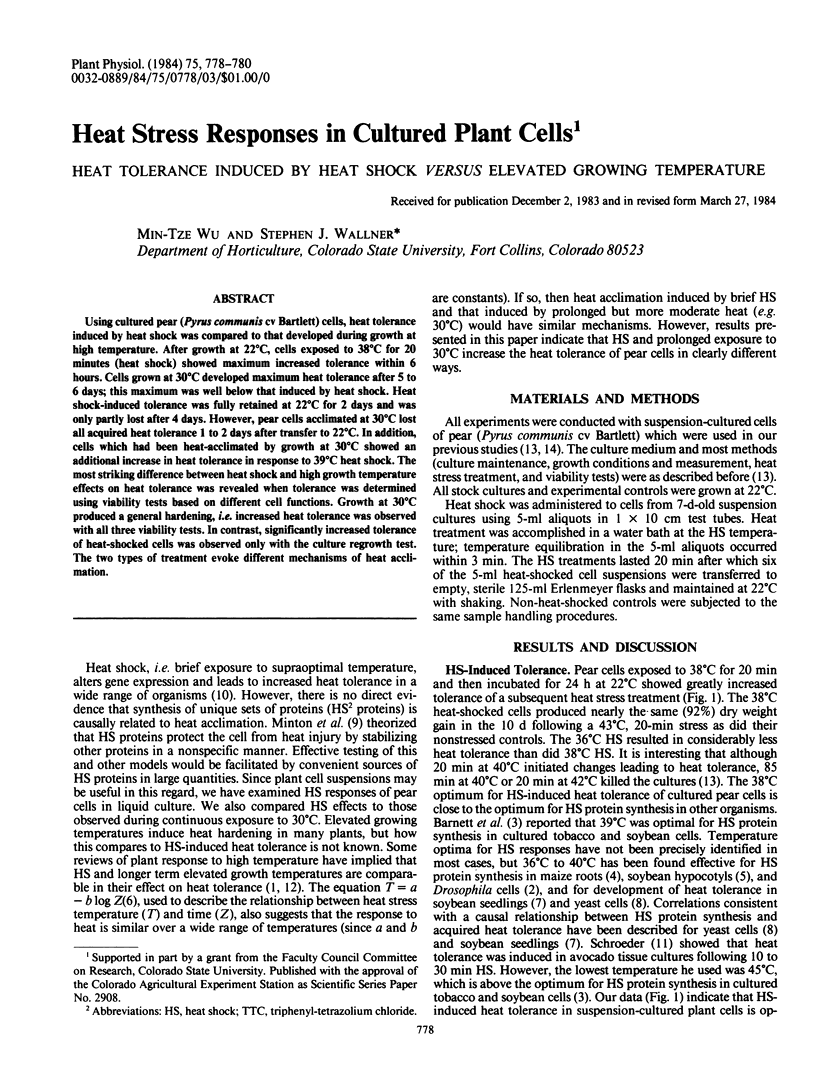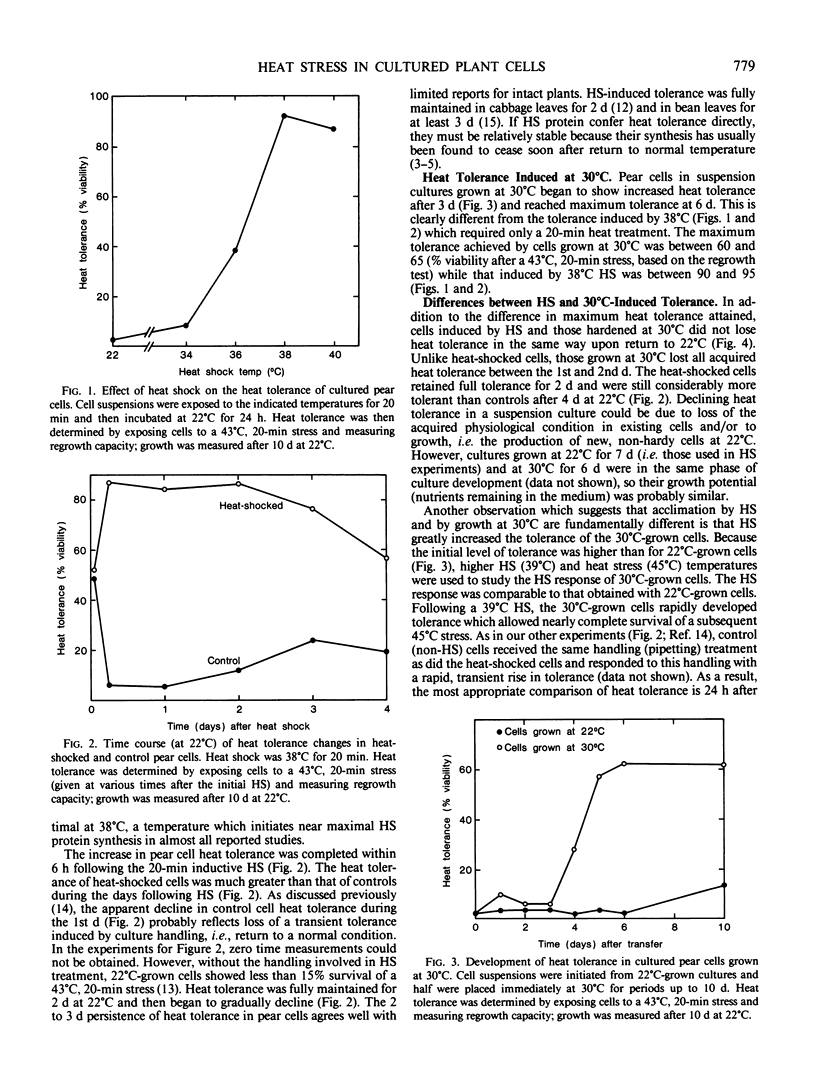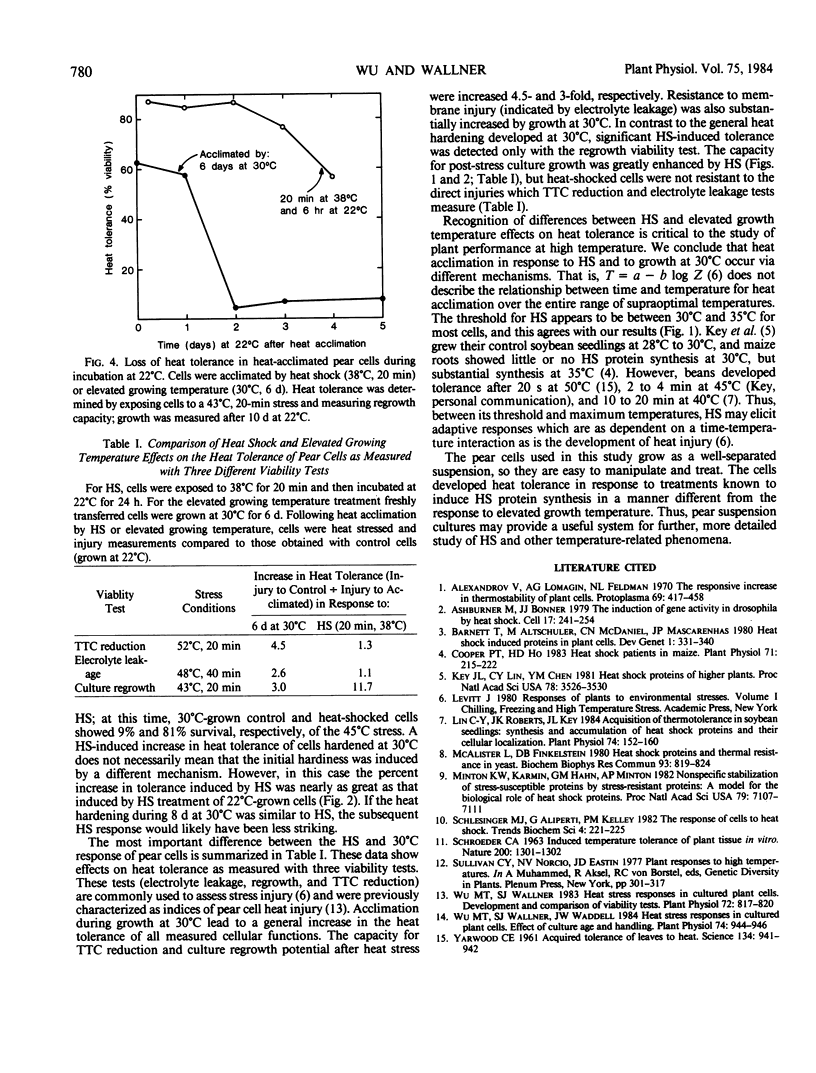Abstract
Using cultured pear (Pyrus communis cv Bartlett) cells, heat tolerance induced by heat shock was compared to that developed during growth at high temperature. After growth at 22°C, cells exposed to 38°C for 20 minutes (heat shock) showed maximum increased tolerance within 6 hours. Cells grown at 30°C developed maximum heat tolerance after 5 to 6 days; this maximum was well below that induced by heat shock. Heat shock-induced tolerance was fully retained at 22°C for 2 days and was only partly lost after 4 days. However, pear cells acclimated at 30°C lost all acquired heat tolerance 1 to 2 days after transfer to 22°C. In addition, cells which had been heat-acclimated by growth at 30°C showed an additional increase in heat tolerance in response to 39°C heat shock. The most striking difference between heat shock and high growth temperature effects on heat tolerance was revealed when tolerance was determined using viability tests based on different cell functions. Growth at 30°C produced a general hardening, i.e. increased heat tolerance was observed with all three viability tests. In contrast, significantly increased tolerance of heat-shocked cells was observed only with the culture regrowth test. The two types of treatment evoke different mechanisms of heat acclimation.
Full text
PDF


Selected References
These references are in PubMed. This may not be the complete list of references from this article.
- Ashburner M., Bonner J. J. The induction of gene activity in drosophilia by heat shock. Cell. 1979 Jun;17(2):241–254. doi: 10.1016/0092-8674(79)90150-8. [DOI] [PubMed] [Google Scholar]
- Cooper P., Ho T. H. Heat shock proteins in maize. Plant Physiol. 1983 Feb;71(2):215–222. doi: 10.1104/pp.71.2.215. [DOI] [PMC free article] [PubMed] [Google Scholar]
- Key J. L., Lin C. Y., Chen Y. M. Heat shock proteins of higher plants. Proc Natl Acad Sci U S A. 1981 Jun;78(6):3526–3530. doi: 10.1073/pnas.78.6.3526. [DOI] [PMC free article] [PubMed] [Google Scholar]
- Lin C. Y., Roberts J. K., Key J. L. Acquisition of Thermotolerance in Soybean Seedlings : Synthesis and Accumulation of Heat Shock Proteins and their Cellular Localization. Plant Physiol. 1984 Jan;74(1):152–160. doi: 10.1104/pp.74.1.152. [DOI] [PMC free article] [PubMed] [Google Scholar]
- McAlister L., Finkelstein D. B. Heat shock proteins and thermal resistance in yeast. Biochem Biophys Res Commun. 1980 Apr 14;93(3):819–824. doi: 10.1016/0006-291x(80)91150-x. [DOI] [PubMed] [Google Scholar]
- Minton K. W., Karmin P., Hahn G. M., Minton A. P. Nonspecific stabilization of stress-susceptible proteins by stress-resistant proteins: a model for the biological role of heat shock proteins. Proc Natl Acad Sci U S A. 1982 Dec;79(23):7107–7111. doi: 10.1073/pnas.79.23.7107. [DOI] [PMC free article] [PubMed] [Google Scholar]
- Wu M. T., Wallner S. J. Heat stress responses in cultured plant cells : development and comparison of viability tests. Plant Physiol. 1983 Jul;72(3):817–820. doi: 10.1104/pp.72.3.817. [DOI] [PMC free article] [PubMed] [Google Scholar]
- Wu M. T., Wallner S. J., Waddell J. W. Heat stress responses in cultured plant cells : effect of culture handling and age. Plant Physiol. 1984 Apr;74(4):944–946. doi: 10.1104/pp.74.4.944. [DOI] [PMC free article] [PubMed] [Google Scholar]
- Yarwood C. E. Acquired Tolerance of Leaves to Heat. Science. 1961 Sep 29;134(3483):941–942. doi: 10.1126/science.134.3483.941. [DOI] [PubMed] [Google Scholar]


